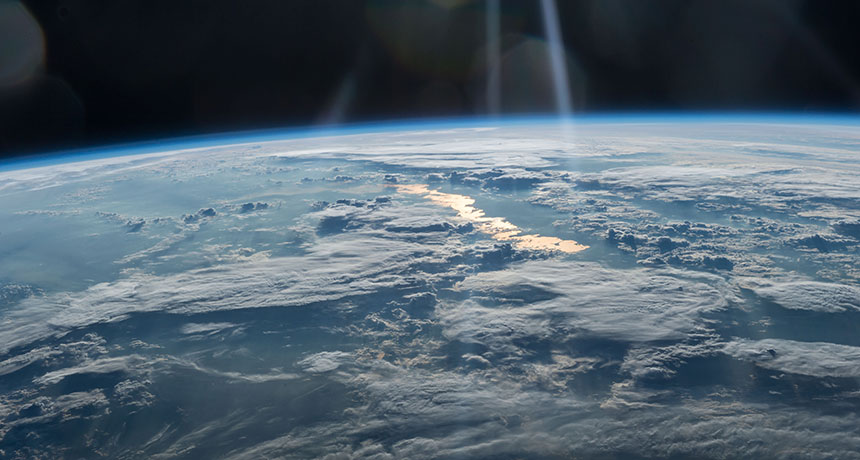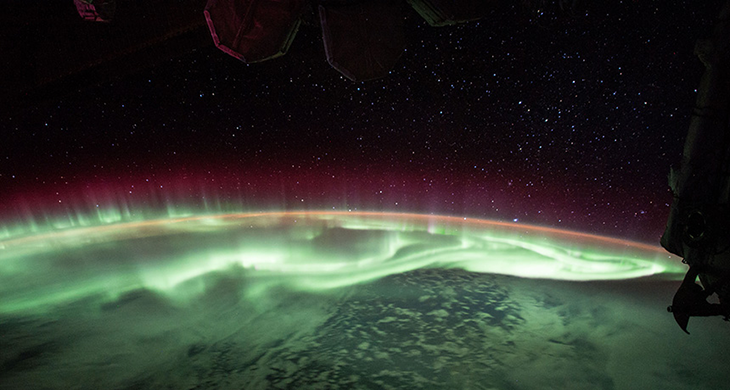Scientists probe how an eclipse affects Earth’s atmosphere
Using smartphones and radio kits, people will track how radio waves move through the ionosphere

Sunlight strips electrons from atoms in Earth’s atmosphere. This process creates a charged layer called the ionosphere. But during a solar eclipse, all of that stops.
NASA
The moon’s shadow will race across North America today. And as that happens, hundreds of radio enthusiasts will turn on their receivers — rain or shine. They will be listening for changes due to eclipse effects on a shell of electrons hundreds of kilometers (miles) overhead. That shell is responsible for heavenly light shows, GPS navigation and all earthly existence. And a solar eclipse offers a great opportunity to study that shell.
A part of the upper atmosphere absorbs a type of radiation from the sun known as extreme ultraviolet light. That absorption prevents this radiation from harming life on Earth. But this energy does alter the upper atmosphere. That extreme ultraviolet light strips electrons from — ionizes — atoms and molecules high above Earth’s surface. Indeed, it creates a zone full of ions. These include free-floating negatively charged electrons and the positively charged atoms or molecules to which they had once belonged. The area where this takes place is known as the ionosphere (Eye-ON-oh-sfeer). Ranging from 75 to 1,000 kilometers (47 to 620 miles) up, this zone warps some signals passing through it.
“The ionosphere is the reason life exists on this planet,” notes Joshua Semeter. Its filtering of the extreme ultraviolet light’s harmful rays protects life on the ground, explains this physicist at Boston University in Massachusetts.
The ionosphere also is a stage for brilliant displays, such as the aurora borealis (or northern lights). This light show appears when charged material in interplanetary space skims the atmosphere. And the ionosphere is important for predicting the accuracy of GPS signals. It also plays a role in radio communication.
Story continues below image.

But at night — or during a solar eclipse — the ionosphere stops ionizing. Electrons start to rejoin the atoms and molecules they had formerly abandoned. This neutralizes their electrical charge. With fewer free electrons bouncing around, the ionosphere reflects radio waves differently. It acts like a distorted mirror.
Scientists had known this happens, but not precisely how. The way that the ionosphere changes at dusk and dawn involves factors other than just sunlight. And these extra factors, such as temperature or the angle of sunlight, might also affect the observations. The eclipse gives researchers a chance, instead, to watch in almost real time that charging and uncharging process.
“The eclipse lets us look at the change from light to dark to light again very quickly,” notes Jill Nelson. She is an electrical engineer at George Mason University in Fairfax, Va.
Delving deeper into the eclipse effect
Joseph Huba and Douglas Drob are scientists at the U.S. Naval Research Laboratory in Washington, D.C. They have just predicted some of what should happen to the ionosphere during this year’s eclipse.
Work during earlier eclipses showed that this part of the atmosphere does not simply die down and then ramp back up again. It takes a while for all of those electrons to rejoin their atoms (or let go again in sunlight). The way the ionization changes during an eclipse seems to depend on its distance from the moon’s shadow.
At higher altitudes, the free electrons’ temperature should decrease by 15 percent, Huba and Drob now propose. Between 150 and 350 kilometers (90 and 220 miles) up, there will be a different change. Here, the density of free-floating electrons should drop by up to half as they rejoin atoms, the scientists say. This should create a magnetic disturbance that would travel along Earth’s magnetic field lines. If true, they say, that eclipse-induced ripple in the ionosphere might be detectable as far away as the tip of South America!
They described their new calculations in the July 17 Geophysical Research Letters.
Story continues below video.
Eclipse Mob is one project that will look at how the 2017 eclipse affects Earth’s atmosphere. Nelson and her colleagues will use volunteers around the United States for the project. Each will send in data on how the ionosphere responds when the sun is briefly blocked. The project will collect these eclipse data from a larger area of land than has ever before.
And here’s how they will do it. About 150 Eclipse Mob participants received a do-it-yourself kit. These allowed each to build a small radio receiver. It can then plug into the headphone jack of a smartphone. (Some volunteers made their own receivers after the project ran out of kits.) On August 21, all of these receivers will look for signals from radio transmitters. They would then record the signal’s strength before, during and after the eclipse.
Nelson isn’t sure what to expect. She only knows that the signal should differ depending on where the receivers are. “We’ll be looking for patterns,” she says. “I don’t know what we’re going to see.”
Boston University’s Semeter and his team also would like to measure the eclipse’s effects on the ionosphere with smartphones. But they won’t do that this year. For now, they will observe radio signals using an existing network of GPS receivers in Missouri. They will intersperse that with small, cheap GPS receivers that are similar to the kind in most phones.
Why GPS receivers? The 2017 eclipse will create a big cool spot. It will launch waves in the atmosphere that will propagate away from the moon’s shadow. Such waves will leave an imprint on the ionosphere that should alter GPS signals. Semeter’s group hopes to combine high-quality data with messier data. What they learn from this could create a basis for future experiments to tap into the smartphone crowd.
“The ultimate vision of this project is to leverage all 2 billion smartphones around the planet,” Semeter says. Someday, everyone with a phone could be a node in a global ionosphere telescope.
If that works, the system it forms might one day prove a lifesaver.
Semeter explains that similar atmospheric waves were seen radiating from the source of the 2011 earthquake off the coast of Japan. “The earthquake did the sort of thing the eclipse is going to do,” he says. Understanding how these waves form and move, he says, could potentially one day help predict earthquakes shortly before they strike.







